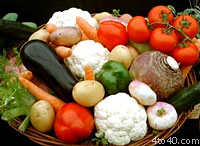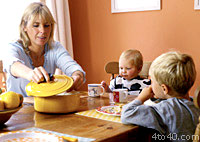 I wanted my kids to be good eaters. It mattered quite a lot to me, in fact. But I wondered, during the breast-pump-and-jar-food days, what I could do to help them grow up liking not only broccoli and oranges but also salmon, parsnips, and sheep’s-milk cheese, as I do. Or was appetite one of those things, like personality and hair color, that’s simply ingrained?
I wanted my kids to be good eaters. It mattered quite a lot to me, in fact. But I wondered, during the breast-pump-and-jar-food days, what I could do to help them grow up liking not only broccoli and oranges but also salmon, parsnips, and sheep’s-milk cheese, as I do. Or was appetite one of those things, like personality and hair color, that’s simply ingrained?
I wish I could say that I was motivated purely by concern for their health, but that was only part of it. I also wanted them to grow up open-minded about new experiences, starting with ones that arrive on a plate. Mostly, I was motivated by self-interest. I love to cook, and longed for eager guinea pigs at the table. I had spent too many years living alone and attempting to divide recipes in fourths, or eating leftovers night after night. What joy to march boldly into a recipe that “serves six”! Joy, that is, as long as my diners would never (okay, only occasionally) utter the word “yucky.”
So I did some research, watched friends with their kids, and talked it over with my husband. He and I have evolved a set of seven rules for raising an adventurous eater, or at least turning a cautious eater into a more adventurous one.
Well, at least they’ve worked for us. At least for now.
As with most such things, I’ve found you have to stick to your guns. Kids learn quickly just how hard they need to cry or how loud to scream until you cave – or that you won’t . And once they realize that, the rest, as they say, is gravy.
Don’t be a short-order cook. At mealtime, we tell our three kids, ages 6, 5, and 2, “This is what’s for dinner. If you don’t like it, that’s fine; you don’t have to eat it. But there isn’t anything else.” They can decide for themselves whether to eat the food in front of them or wait until breakfast. The American Academy of Pediatrics gave me the courage to follow through with this idea. Around the time George, now 6, was learning to say “No!” I read the following passage in their Guide to Your Child’s Nutrition: “Children will not become ill or suffer permanently if they refuse a meal or two, but parents sometimes act as though youngsters might shrivel up and die.”
Give foods a little kick
Don’t dumb down the food. True, kids have delicate taste buds, but that doesn’t mean they should be served a steady diet of pasta with butter. In fact, it’s all the more reason to give them flavorful food; with their naturally sensitive palates, children really notice when something tastes good.
I expected my kids to shun garlic when they were babies, for instance. And surely, I thought, they’d hate olives. But a little garlic makes so many things taste better that even a 1-year-old can enjoy the difference. And olives can be wonderful if they’re the mild, fragrant kind marinated in oil and herbs. I do go out of my way to avoid very spicy foods and funky, stinky things like blue cheese. But other than that, I cook the same kinds of meals for my family that I used to cook for friends.
Champion vegetables. This food group is traditionally a mom’s biggest hurdle, and it’s easy to understand why. Boiled and salted, vegetables are typically nothing more than the good-for-you side dish, dumped by the ladleful alongside things that actually taste good. No wonder getting kids to eat them requires begging and threats, tactics that quickly backfire. Because once your kids realize that you really, really want them to eat vegetables, refusing to do so becomes a power struggle that they can easily win.
So I learned to go about the vegetable challenge differently, by using recipes that integrate them into delicious main dishes, such as eggplant layered with spiced ground lamb, and sautéed zucchini with tomato and basil. And I made lots of vegetable-based sauces for pasta. Here’s one recipe our kids like:
Smashed peas with rice
This dish can be made in about 20 minutes and serves four people. The mashed peas are also good as a dip with toasted pita bread or crackers – a great way to sneak in veggies.
- 1 cup rice
- 2 Tbs butter
- ½ small onion, finely chopped (about ½ cup)
- 1 clove garlic, minced
- 10-oz package frozen peas
- Pinch salt
- ¼ cup chicken broth or prepared bouillon
- 30 basil leaves (about 1 cup loosely packed)
- cup grated parmesan cheese
1. Prepare rice according to package directions.
2. Meanwhile, melt butter in a skillet over medium heat.
Add the chopped onion and cook, stirring frequently, until quite soft but not brown, about 8 minutes. Add the garlic and cook 2 minutes more. Add the peas and a pinch of salt, stir thoroughly with the garlic and onion mixture, then add the chicken broth. Cover pan and bring to a boil; boil 2 minutes (not more, or the peas will be overdone).
3. Remove from heat and transfer contents to the bowl of a food processor. Add the basil leaves. Process for about 15 seconds, until the peas are beginning to be mashed and the basil is chopped but there are still many whole pieces of pea in the mixture. Combine thoroughly with the cooked rice and parmesan cheese. Serve immediately.
On the nights that I do serve vegetables as a side dish, I’ll often place them on the table first, when my kids are hungriest. They’ve wolfed them down by the time the rest of the meal arrives.
Champion the family table
 Respect family dinnertime. We try to eat together almost every night. So that our kids appreciate this ritual without feeling coerced into it, here’s what we decided: If one of our two older kids is finished eating, he can leave the table, but he can’t hang around nearby, playing and talking and distracting the rest of us. He has to go into the living room or upstairs. Usually, what he really wants is our company and attention, so he’ll stay in his seat. My husband and I have our own rules to obey, too: We don’t answer the phone or watch TV during dinner.
Respect family dinnertime. We try to eat together almost every night. So that our kids appreciate this ritual without feeling coerced into it, here’s what we decided: If one of our two older kids is finished eating, he can leave the table, but he can’t hang around nearby, playing and talking and distracting the rest of us. He has to go into the living room or upstairs. Usually, what he really wants is our company and attention, so he’ll stay in his seat. My husband and I have our own rules to obey, too: We don’t answer the phone or watch TV during dinner.
You have to try one bite. And no more, if what your child tastes makes him or her gag. Like most parents, I have childhood memories of being forced to eat foods that turned my stomach, and I don’t want to subject my kids to that. Some moms I know are so worried they won’t be able to tell the difference between genuine revulsion and mere balkiness that they let their kids off the hook at the first sign of refusal. But it has actually turned out to be easy to tell when a dish is truly nauseating to one of my kids, at which point I’ll quietly let him know that he doesn’t have to finish it.
If all else fails, use bribery (and don’t feel guilty). My kids may be open-minded about food, but that doesn’t mean they always like what I’ve cooked. Heck, I don’t always like what I’ve cooked. But eating it isn’t torture. Yes, my kids can decline the meal, but if they start poking food around on their plates, eating a bite of this but none of that, or acting stubborn or sulky, we resort to the same bag of tricks that our parents used:
No dessert if you don’t eat dinner.
No seconds until you clean your plate (but then seconds can be whatever part of the meal you like).
Or, the most mysteriously effective one of all, “I see you’re not eating your chicken. Mind if I give it to your brother?” at which point, some inexplicable competitive urge kicks in, and the petulant child turns into a food-eating dynamo and polishes off everything on his plate.
Save room for dessert. I can’t lie: Sometimes ice cream tastes better than anything on the planet. Life has its share of sweetness and serendipity, and mealtime should, too.
 Kids Portal For Parents India Kids Network
Kids Portal For Parents India Kids Network






